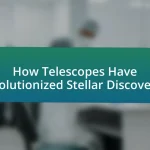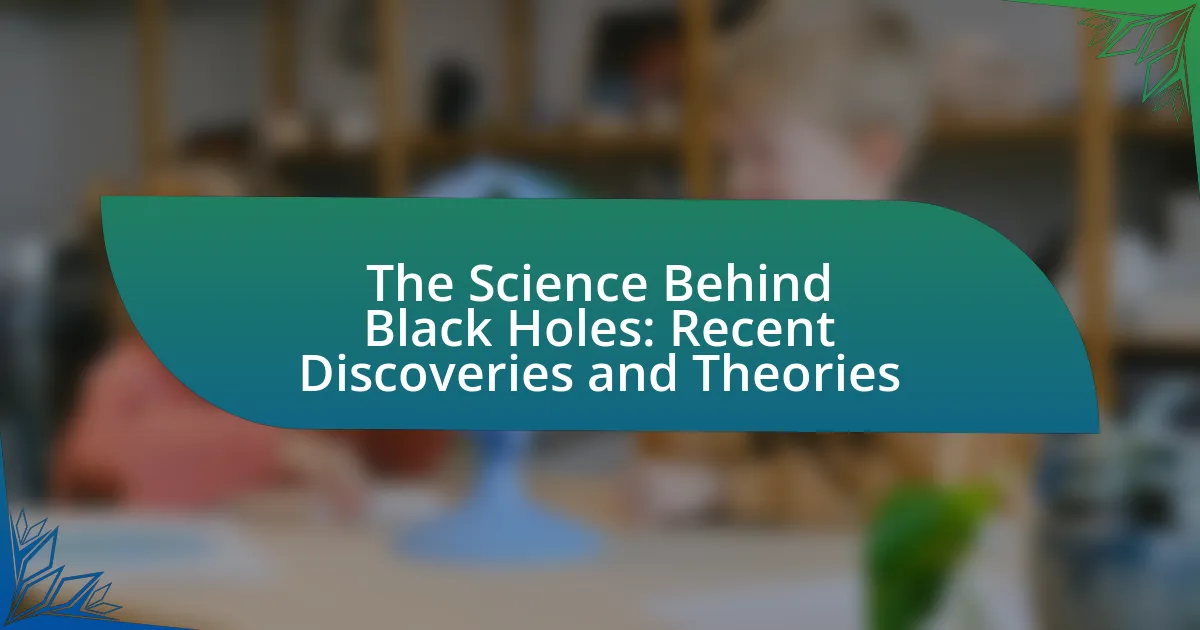The article “A Beginner’s Guide to Observing Stars: Tools and Techniques” serves as a comprehensive resource for novice astronomers interested in stargazing. It emphasizes the significance of star observation for understanding the universe and highlights the mental health benefits associated with stargazing. Key topics include essential tools for beginners, such as telescopes and star charts, techniques for effective observation, and the impact of light pollution on visibility. Additionally, the article outlines basic astronomical concepts, common challenges faced by beginners, and best practices for a successful stargazing experience, providing a well-rounded foundation for those new to astronomy.
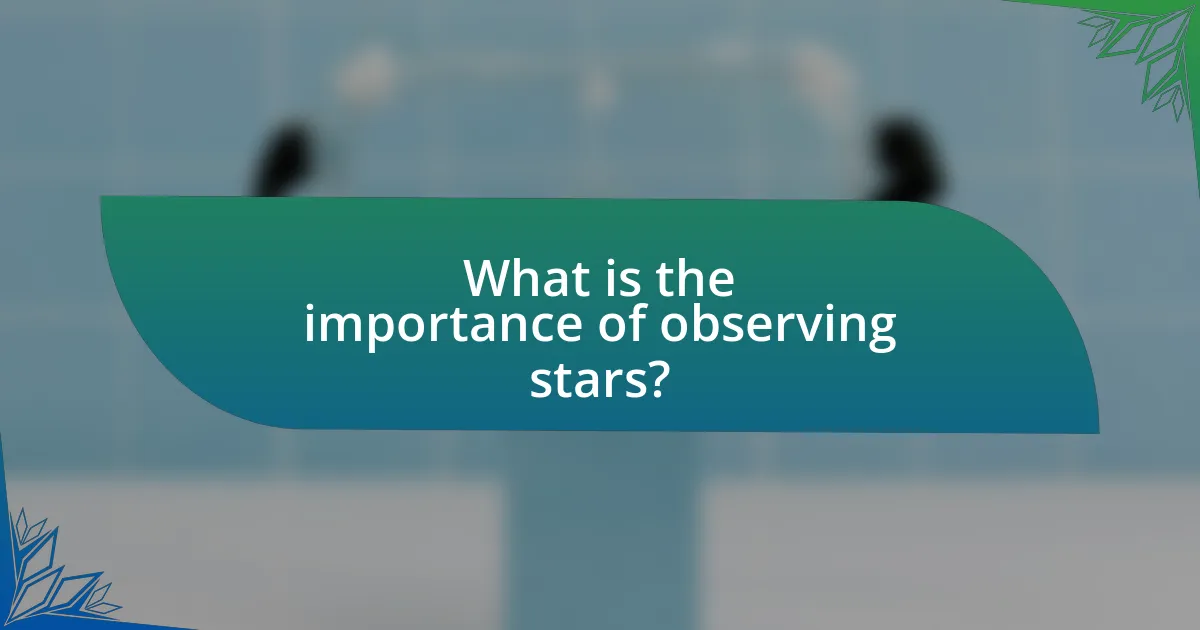
What is the importance of observing stars?
Observing stars is crucial for understanding the universe, as it allows astronomers to gather data about celestial bodies, their compositions, and their behaviors. This observational practice has led to significant discoveries, such as the identification of exoplanets and the understanding of stellar evolution. For instance, the Hubble Space Telescope has provided insights into the age of the universe and the expansion rate, demonstrating the importance of star observation in advancing astrophysics.
Why should beginners start observing stars?
Beginners should start observing stars to develop a deeper appreciation for astronomy and the universe. Engaging in stargazing enhances observational skills and fosters curiosity about celestial phenomena. Research indicates that stargazing can improve mental well-being by promoting mindfulness and reducing stress, as noted in a study published in the Journal of Environmental Psychology, which found that nature-based activities, including stargazing, contribute positively to mental health. Additionally, observing stars provides foundational knowledge about constellations, planets, and the night sky, which can lead to more advanced studies in astronomy.
What are the benefits of stargazing for mental health?
Stargazing significantly benefits mental health by reducing stress and promoting relaxation. Engaging with the vastness of the night sky can foster a sense of awe and perspective, which helps alleviate feelings of anxiety and depression. Research published in the journal “Psychological Science” indicates that exposure to natural environments, including stargazing, enhances mood and overall well-being. Additionally, the act of observing stars can encourage mindfulness, allowing individuals to focus on the present moment, further contributing to improved mental health outcomes.
How does stargazing enhance our understanding of the universe?
Stargazing enhances our understanding of the universe by allowing individuals to observe celestial bodies and phenomena, which leads to the collection of data that informs scientific theories and models. Through telescopes and other observational tools, astronomers can study the composition, distance, and behavior of stars, planets, and galaxies. For example, the Hubble Space Telescope has provided insights into the expansion of the universe and the existence of exoplanets, supporting theories such as the Big Bang and the potential for life beyond Earth. This empirical evidence gathered from stargazing contributes to a deeper comprehension of cosmic events and the fundamental laws governing the universe.
What are the basic concepts of astronomy relevant to stargazing?
The basic concepts of astronomy relevant to stargazing include celestial coordinates, the celestial sphere, light years, and the phases of celestial objects. Celestial coordinates, which consist of right ascension and declination, help locate stars and other celestial bodies in the sky. The celestial sphere is an imaginary sphere surrounding Earth, where stars appear to be projected, aiding in visualizing their positions. Light years measure the distance light travels in one year, providing a scale for the vast distances between stars. Additionally, understanding the phases of celestial objects, such as the moon’s phases, is crucial for predicting visibility and observing changes in the night sky. These concepts form the foundation for effective stargazing and enhance the overall experience of observing celestial phenomena.
What is the difference between stars, planets, and constellations?
Stars are luminous celestial bodies composed primarily of hydrogen and helium that generate energy through nuclear fusion, while planets are non-luminous objects that orbit stars and do not produce their own light, instead reflecting the light of their parent star. Constellations, on the other hand, are patterns formed by groups of stars as seen from Earth, serving as a way to organize and identify different regions of the night sky. The distinction lies in their fundamental characteristics: stars are self-luminous, planets are reflective and orbiting, and constellations are visual groupings of stars.
How do celestial coordinates work for locating stars?
Celestial coordinates work by providing a systematic way to pinpoint the location of stars in the sky, similar to how geographic coordinates locate points on Earth. The celestial coordinate system uses two primary measurements: right ascension (RA) and declination (Dec). Right ascension is analogous to longitude and measures the angle eastward along the celestial equator, while declination is similar to latitude and measures the angle north or south of the celestial equator.
This system allows astronomers to specify the position of celestial objects with precision. For example, the star Betelgeuse has a right ascension of approximately 5 hours 55 minutes and a declination of +7 degrees 24 minutes. These coordinates enable observers to locate Betelgeuse in the night sky regardless of their geographical location on Earth. The use of celestial coordinates is standardized, making it a reliable method for locating stars and other celestial bodies.
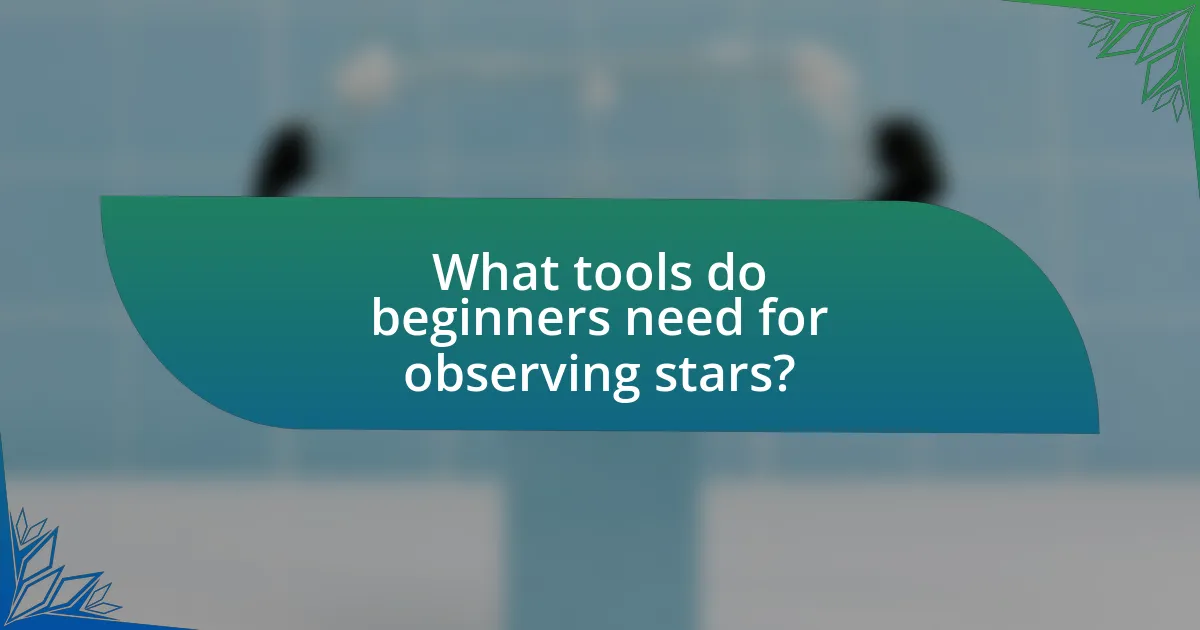
What tools do beginners need for observing stars?
Beginners need a few essential tools for observing stars, including a star chart or mobile app, binoculars, and a telescope. A star chart or app helps identify constellations and celestial objects, providing a guide for navigation in the night sky. Binoculars offer a wider field of view and are portable, making them ideal for beginners to observe star clusters and the moon’s surface. A telescope, while more advanced, allows for detailed observation of planets and deep-sky objects. These tools are widely recommended by astronomy organizations, such as the American Astronomical Society, which emphasizes their importance for novice stargazers.
What are the essential tools for stargazing?
The essential tools for stargazing include a telescope, binoculars, a star chart or stargazing app, and a red flashlight. A telescope allows for detailed observation of celestial objects, while binoculars provide a portable option for viewing stars and constellations. Star charts or stargazing apps help identify and locate celestial bodies, enhancing the experience. A red flashlight preserves night vision, making it easier to navigate in the dark. These tools are widely recommended by astronomy enthusiasts and organizations, such as the American Astronomical Society, for effective stargazing.
What types of telescopes are suitable for beginners?
Refractor telescopes and reflector telescopes are suitable for beginners. Refractor telescopes use lenses to gather light and are known for their ease of use and low maintenance, making them ideal for novice astronomers. Reflector telescopes utilize mirrors to collect light and often provide larger apertures for a lower cost, allowing beginners to observe fainter objects in the night sky. Both types offer a good balance of portability and performance, which is essential for those just starting in astronomy.
How do binoculars compare to telescopes for stargazing?
Binoculars are generally more portable and user-friendly than telescopes for stargazing, making them ideal for beginners. They provide a wider field of view, allowing users to easily locate celestial objects, while telescopes offer higher magnification and detail for observing specific targets like planets and deep-sky objects. For instance, binoculars typically have magnifications ranging from 7x to 10x, which is sufficient for viewing the moon and some star clusters, whereas telescopes can exceed 100x magnification, revealing finer details. This difference in functionality makes binoculars suitable for casual stargazing, while telescopes are better for in-depth astronomical observation.
What accessories can enhance the stargazing experience?
Accessories that can enhance the stargazing experience include telescopes, binoculars, star charts, and red LED flashlights. Telescopes provide detailed views of celestial objects, allowing for deeper exploration of planets and galaxies. Binoculars offer a portable option for observing the night sky with a wider field of view. Star charts help identify constellations and celestial events, making navigation easier for beginners. Red LED flashlights preserve night vision, enabling users to see without disrupting their ability to observe stars. These accessories collectively improve the quality and enjoyment of stargazing.
How do star charts and apps assist in locating stars?
Star charts and apps assist in locating stars by providing visual representations of the night sky, indicating the positions of celestial objects. Star charts are graphical maps that depict constellations and stars, allowing users to identify and locate them based on their orientation and time of year. Apps enhance this experience by utilizing GPS technology to align the star map with the user’s location, offering real-time tracking and augmented reality features that overlay star names and information directly onto the sky. For instance, apps like SkySafari and Star Walk have been shown to improve stargazing experiences by making it easier for users to find specific stars and constellations, thereby increasing engagement and knowledge of astronomy.
What role do red flashlights play in preserving night vision?
Red flashlights play a crucial role in preserving night vision by emitting light in the red spectrum, which is less disruptive to the eyes’ adaptation to darkness. The human eye is more sensitive to wavelengths of light in the blue and green spectrum, which can cause temporary blindness and hinder night vision. In contrast, red light has a minimal impact on the photopigments in the retina, allowing for better visibility of stars and celestial objects while maintaining the ability to see in low-light conditions. This is supported by studies indicating that red light preserves the eye’s dark adaptation, making it an essential tool for astronomers and stargazers.
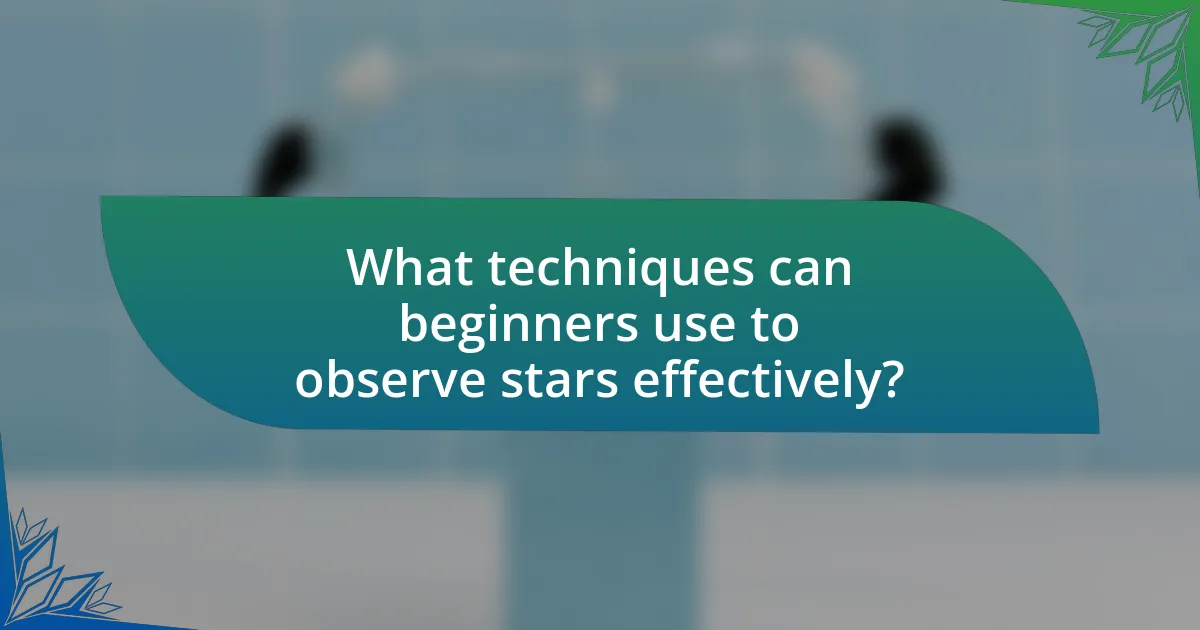
What techniques can beginners use to observe stars effectively?
Beginners can effectively observe stars by using techniques such as choosing a dark location, utilizing star charts or apps, and employing binoculars or telescopes. Selecting a dark site minimizes light pollution, which enhances visibility of celestial objects; studies show that light pollution can reduce the visibility of stars by up to 90% in urban areas. Star charts or mobile applications help beginners identify constellations and stars, providing a structured approach to learning the night sky. Additionally, using binoculars or telescopes allows for a closer view of stars and other celestial bodies, making the experience more engaging and informative.
How can beginners choose the best locations for stargazing?
Beginners can choose the best locations for stargazing by selecting areas with minimal light pollution, high elevation, and clear skies. Light pollution significantly hinders visibility of celestial objects; therefore, locations far from urban areas, such as national parks or rural settings, are ideal. High elevation sites, like mountains, reduce atmospheric interference, enhancing clarity. Additionally, checking weather forecasts for clear nights ensures optimal viewing conditions. According to the International Dark-Sky Association, areas designated as dark sky parks provide excellent stargazing opportunities due to their commitment to reducing light pollution.
What factors should be considered when selecting a stargazing site?
When selecting a stargazing site, key factors include light pollution, elevation, accessibility, and weather conditions. Light pollution significantly affects visibility; areas far from city lights provide clearer views of celestial objects. Elevation enhances visibility by reducing atmospheric interference; higher altitudes often yield better stargazing experiences. Accessibility ensures that the site can be reached easily, which is crucial for safety and convenience. Lastly, favorable weather conditions, such as clear skies and low humidity, are essential for optimal stargazing. These factors collectively contribute to a successful stargazing experience.
How does light pollution affect star visibility?
Light pollution significantly reduces star visibility by overwhelming the natural light emitted by stars with artificial light sources. This excess illumination creates a bright sky background, making it difficult for the human eye to detect fainter stars and celestial objects. Studies indicate that in urban areas, up to 80% of stars may become invisible due to light pollution, as the contrast between the stars and the sky diminishes. Consequently, this phenomenon not only affects amateur astronomers but also impacts scientific observations and our overall connection to the night sky.
What are some tips for improving stargazing skills?
To improve stargazing skills, one should practice regularly in dark, clear locations away from city lights. This practice enhances the ability to identify constellations and celestial objects. Using a star chart or stargazing app can provide guidance on what to look for, making it easier to locate stars and planets. Additionally, investing in a good pair of binoculars or a telescope can significantly enhance the viewing experience by revealing more details of celestial bodies. Observing during different seasons also helps in recognizing how the night sky changes, thereby improving overall stargazing proficiency.
How can patience and practice enhance the stargazing experience?
Patience and practice significantly enhance the stargazing experience by allowing individuals to develop observational skills and a deeper understanding of celestial phenomena. With patience, stargazers can wait for optimal viewing conditions, such as clear skies and minimal light pollution, which are crucial for seeing faint stars and celestial events. Practice enables individuals to familiarize themselves with star patterns, constellations, and the movement of celestial bodies, improving their ability to identify and appreciate what they observe. Research indicates that experienced stargazers can recognize constellations and celestial events more quickly, leading to a more rewarding experience. Thus, both patience and practice are essential for maximizing the enjoyment and educational value of stargazing.
What techniques can help in identifying constellations?
Techniques that can help in identifying constellations include using star charts, mobile apps, and the naked eye method. Star charts provide a visual representation of the night sky, allowing observers to match the patterns of stars with their corresponding constellations. Mobile apps utilize augmented reality to overlay constellation outlines on the live view of the sky, making identification easier. The naked eye method involves recognizing prominent stars and their arrangements, often starting with well-known constellations like Orion or Ursa Major, which serve as reference points for locating others. These techniques are effective for beginners and enhance the overall stargazing experience.
What common challenges do beginners face when observing stars?
Beginners face several common challenges when observing stars, including light pollution, lack of knowledge about constellations, and inadequate equipment. Light pollution significantly hampers visibility, as urban areas often have excessive artificial lighting that obscures faint stars. Additionally, many beginners struggle with identifying constellations and celestial objects due to limited familiarity with star maps and guides. Furthermore, using inappropriate or low-quality equipment, such as binoculars or telescopes that are not suited for stargazing, can lead to disappointing experiences and hinder effective observation. These challenges are well-documented in astronomy education resources, highlighting the importance of proper preparation and understanding for successful stargazing.
How can weather conditions impact stargazing?
Weather conditions significantly impact stargazing by affecting visibility and atmospheric clarity. Clear skies with low humidity and minimal light pollution provide optimal conditions for observing celestial objects, while overcast skies, rain, or high humidity can obscure stars and planets. For instance, clouds can block light from celestial bodies, making them invisible, while atmospheric turbulence caused by wind can distort images of stars, leading to twinkling effects. According to the American Meteorological Society, clear nights with stable air conditions are ideal for astronomical observations, as they enhance the sharpness and brightness of celestial objects.
What should beginners do if they encounter equipment issues?
Beginners should first consult the equipment manual to troubleshoot any issues they encounter. This step is crucial as manuals often provide specific guidance on common problems and solutions. If the manual does not resolve the issue, beginners should seek assistance from online forums or communities dedicated to stargazing, where experienced users can offer advice based on similar experiences. Additionally, contacting customer support for the equipment can provide professional assistance and potentially resolve the issue effectively.
What are some best practices for a successful stargazing experience?
To ensure a successful stargazing experience, choose a dark location away from city lights, as light pollution significantly hinders visibility of celestial objects. Additionally, check weather conditions for clear skies, since clouds and humidity can obstruct views. Using a star chart or stargazing app enhances navigation of the night sky, allowing for easier identification of constellations and planets. Allowing your eyes to adjust to the darkness for at least 20 minutes improves night vision, making faint stars more visible. Finally, bringing a comfortable blanket or chair can enhance the overall experience, allowing for longer observation periods without discomfort.
How can beginners prepare for a night of stargazing?
Beginners can prepare for a night of stargazing by selecting a dark location away from city lights, checking the weather for clear skies, and bringing essential equipment such as a star chart or stargazing app. A dark location minimizes light pollution, which enhances visibility of celestial objects; studies show that light pollution significantly reduces the number of visible stars. Clear weather is crucial, as clouds obstruct views of the night sky. Using a star chart or app helps beginners identify constellations and planets, making the experience more engaging and educational.
What are the best times of year for observing specific celestial events?
The best times of year for observing specific celestial events include various months tailored to particular phenomena. For meteor showers, the Perseids peak around August 12, while the Geminids peak around December 14. Eclipses, both solar and lunar, occur at different times; for instance, a total solar eclipse can happen roughly every 18 months, with notable occurrences in 2024 and 2025. Planetary alignments are best observed in the spring and fall, particularly in May and November, when planets are more visible in the evening sky. These timings are based on historical patterns and astronomical predictions, ensuring optimal viewing conditions for enthusiasts.


